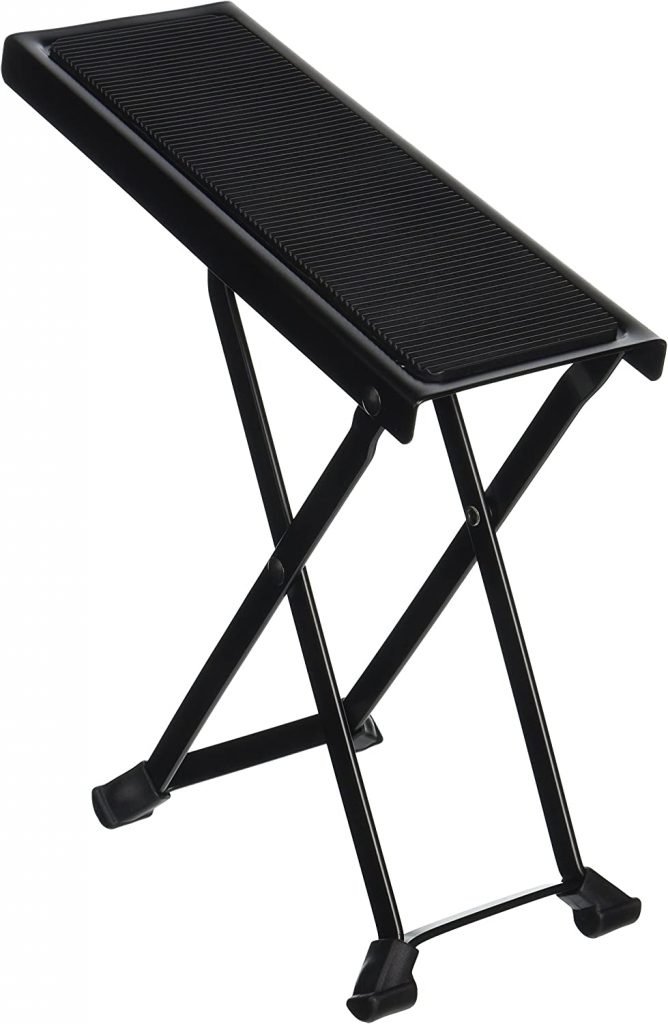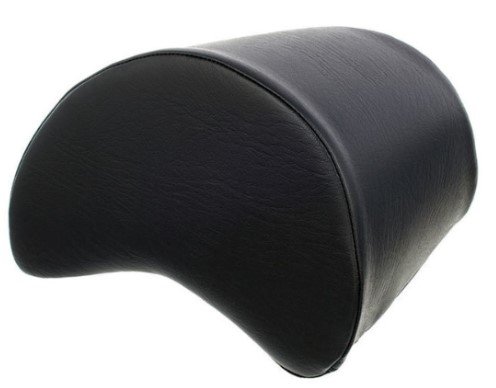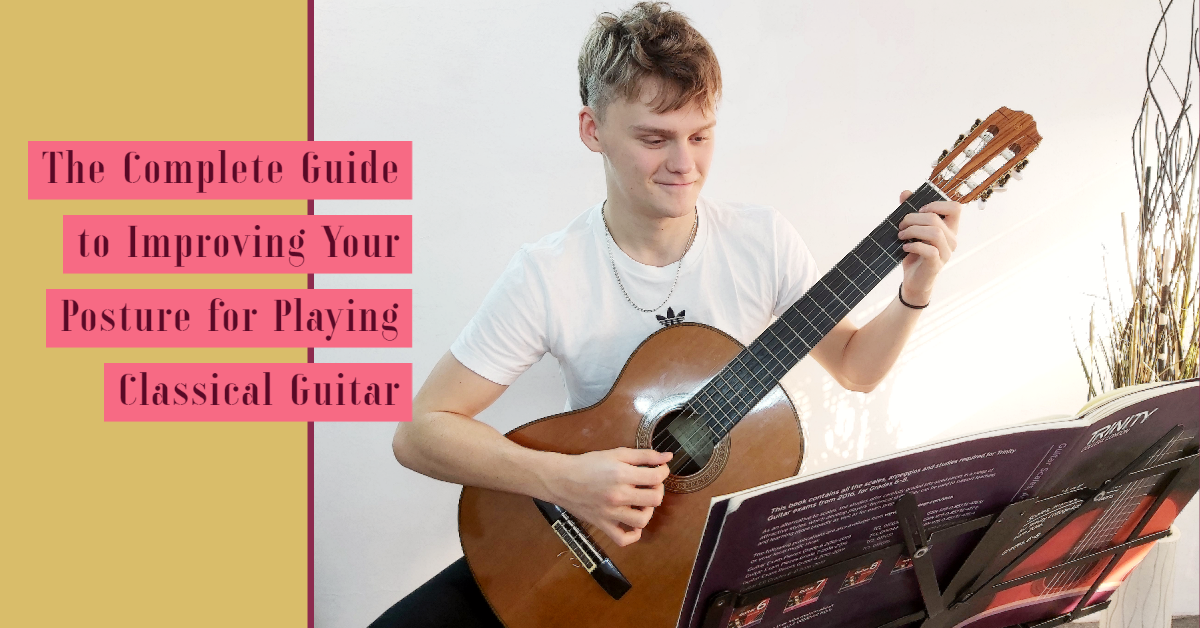Playing the classical guitar is a fun and relaxing hobby for many people. It can be a great way to spend some time with friends or family. But, it can also be stressful on the body if you don’t have good posture. In order to play the guitar without any pain, it is important to follow some basic guitar-playing posture guidelines. These include sitting up straight, holding the instrument correctly, and keeping your shoulders relaxed. Posture in general is the position of the body in which it is standing or sitting and working. Good posture helps to maintain a healthy back and spine, improves circulation, and reduces fatigue and muscle strain.
In order to play guitar well, you should have good posture. It will help you achieve better tone quality and sound. The classical guitar posture is usually with one leg elevated on the footstool. This article introduces the basics of classical guitar posture. It also includes an introduction to why this posture is important for both playing and practicing classical guitar as well as some common mistakes that guitar students make.
The Basics of the Guitar Posture
For correct body posture while playing guitar you will need a specific chair and footstool, or any other device that can elevate the guitar.
- The chair that you will sit on should be of normal height and without armrests, that is very important. It should not be very soft or very hard. It can also be a bunch. It is not recommended to sit on a sofa, bin bag, etc.
- The Foot Stool is a small adjustable device that elevates your left leg (or right leg if you are a left-handed guitarist) its height has to be adjustable, which will allow you to control the leg elevation which is closely related to the guitar position.

Other devices that can replace the footstool
- Guitar supports usually are metal or plastic adjustable brackets. They stick on the bottom part of the guitar body usually with suction cups.

- Cushions– The guitar player places the cushion on the leg that they want to elevate and places the guitar on it. In such a way both feet remain on the floor which is supposedly more physically appropriate.

A good guitar posture is one where you are comfortable and in control of all your movements. This will allow you to play better, longer, and with less fatigue. You should also be able to maintain this position for hours without feeling any discomfort or pain. However, this is easier said than done.
Classical guitar posture is the position of the instrument towards the body and hands. The main characteristics of the classical guitar posture are:
- Position of the body
- Position of the guitar
- Position of the hands
- Position of the fingers
What is the Correct Body Position to Play Classical Guitar?
The correct body position to play classical guitar is a question that has been asked by many guitarists. The answer to the question is not a simple one, but there are some factors that can help you find the ideal posture for playing. I will try to describe it as simply as possible. Most of the things are not written in stonе, but there are some basic principles.
Sit on the edge of the chair, place your left leg on the footstool, and the right leg opens to the right. Keep the body straight but not tense. Place the guitar with its waste on your left tie. Place the right forearm on the top of the guitar in such a way that the fingers can reach the strings. That is in general. I recommend you follow your teacher’s instructions, simply because this is in general. We all have different body types different limbs length etc. It is not a good idea to copy someone’s posture blindly, just because they are a good player. If a certain body posture works for them it will not necessarily work for you or for me. So, my advice here is to follow your teacher they have more experience and it will save you a lot of disappointments.
The Correct Position of the guitar
Sit us described above, place the guitar waste on your left tie, the guitar head should be somewhere on the level of your head, this is not always it depends on many factors. the bottom part of the guitar should be slightly outwards so its face points slightly up not parallel to the floor. The right side of the guitar should be slightly in and the fretboard side slightly out. The top part of the eight” shape should be somewhere in the middle of your body. In general, this is the position of the guitar.
The Position of the hands
When we talk about hand position in classical guitar we need to distinguish between both hands. We will split this segment into two sections one will be the right hand and one will be the left hand. In the classical guitar, each hand has a totally different purpose. Unlike in other instruments such as piano, for example. Both hands in guitar, violin, and other string instruments do totally different things.
Left hand
The purpose of the left hand is to prepare the sounds. Its duty is to press the strings on corresponding fret or frets. The left hand gets the sounds ready. While the right hand produces them. In other words, the purpose of the left hand is to press the strings here and there on the fretboard. Press one string at a time two strings at a time 3, 4, 5, etc. Up until six strings at a time, that is the purpose of the left hand.
To be able to complete this task, the left hand should maintain a certain position. To aline the fingertips in a way that they press in the most efficient way. With fewer efforts, with the speed that we need and at any time we need. We position the wrist in a way that it will allow each finger to press with its tip any string without touching with its finger pad the bottom string. Again, this is not written in stone. The hand is alive it moves, it does too many things.
The left-hand thumb
should be in the back of the neck almost vertical. Make sure the thumb doesn’t stick out on the top of the neck. Basically, the right-hand holds itself. Not by hooking the temp on the neck of the guitar as many acoustic and electric guitar players do all the time. In electric and acoustic guitar that is somehow acceptable, sometimes it is a must.
If you’re a beginner or if you want to improve your technique your posture etc. I do not recommend you hook with your thumb on the neck of the guitar. The thumb should be in the back always ready to be released when we’re doing shifts when the fingertips are playing in the upper part of the fretboard. Or moving vertically in the lower part of the fretboard. The temp is there to kind of support the fingers and also to shape the left-hand posture in general.
The left wrist
shouldn’t pop out too much. Many beginners tend to think that they need to curve, elevate or pop out their left-hand wrist. So their fingertips fall more perpendicular to the strings. That is not a good approach, try to avoid it. Keep the wrist in a neutral position as much as possible. I don’t like to specify angles or measurements because the students tend to take that literally. It is very easy to get caught up. Just try to keep your hand, especially your wrist in a relaxed, natural position.
The Right-Hand Posture
the right-hand posture is one of the most important features of the classical guitar. basically, that is what makes classical guitar playing different than the other guitars. there are many schools that have thoughts about how the right hand should be positioned how the fingers should attack the strings etc but there are several main things that are in common.
The right-hand posture is a very delicate and complex matter that has to be worked and set properly at the beginning of the guitar journey. Here is some general advice:
The forearm
Suppose to rest somewhere above the bridge but this depends and varies from player to player. index middle and ring fingers blunted on strings 3/2 and one respectively should be slightly curved and relaxed the thump planted or late on string 4 should be able to reach strings five and six without problems. The thumb should be positioned slightly ahead of the fingers to create room for them to work. The thumb should be somewhere at the end of the resound hall well the fingers should be slightly out a little bit to the right.
Do not start building your posture yourself
I do not recommend attempting to build your posture yourself. At least at the beginning when you don’t have enough information on how the hand works and how the sound production works etc. The best to find a guitar teacher who can examine your hand well and help you to build your posture. this is a slow process it takes a lot of time and dedication. Your understanding of good sound and understanding of music, in general, will urge you, and will provoke your desire and necessity to produce high-quality music.
Improve your musicianship
One of the best things to do in parallel with working on your technicality is to improve your general musicianship. Listen to as much music as possible. Listen to a lot of classical guitar music in particular. Also, watch different players and observe their right-hand posture. At the same time do not try to copy blindly any guitar player, regardless of how good they are. As we said earlier, if something works for them well it’s not necessary that it will work for you.
Right-hand mistakes that you shouldn’t do or that you have to try to avoid.
- Try not to touch the face of the guitar with no finger or part of the right hand. The face board of the guitar is the one that transmits the sound that is produced by the strings any part of our hand that touches the board will prevent that part of the board from vibrating and therefore from transmitting the sound as we know the classical guitar is not an as loud instrument. And we should be very cautious off not losing any sound.
- Try to keep the wrist in a neutral position and do not go to extremes in any direction. In the long run that can cause problems not only in the wrist but also in the arm. That can cause also nerve problems and other issues that will be very hard to deal with once they occur.
- The right-hand position regardless of how good it is and how correct it is shouldn’t be kept at all times, in the same way. Do not forget that you play on all strings in different manners depending on what the music requires. For example, to play a rest stroke on string one requires one type of position of the hand while playing a rest stroke on string six requires totally different position of the wrist, the forearm the angle of the fingers, etc.
- Do not play with pain, if you experience any unusual pain in any part of the body or the hands, just stop.
Common Problems Caused by Poor Guitar Posture and How to Fix Them
Poor posture can cause many problems such as back pain, neck pain, headaches, and more. The most common problem caused by bad posture is that it can affect your guitar playing. But there are some that can affect your health.
How can you understand that your posture is not good or not correct or not appropriate? it is not black and white but there will be some symptoms if you want:
- one of the most common manifestations of poor posture is the low quality of the sound and unevenness in playing That alone is enough to alarm that something with your posture is not right. It may not be the posture but in most cases it is.
- Pain in one or both wrists
- Back pain is usually related to the body posture in general
- Pain in the elbows
- Pain in the neck
- Sometimes headache
- Unnecessary muscle tension in different parts of the body and hands
- Numbness in some fingers
- Unable to play for prolonged periods of time
- Problems with the speed
- Problems with the accuracy
- Left- and right-hand coordination problems
What may happen if a bad guitar posture causes problems?
Some of those symptoms may lead to very serious injuries. One of the most dangerous things that can happen is nerve-related problems. One can develop carpal tunnel inflammation and degeneration of the nerves, tendonitis, and so on, to name just a few…
It is highly likely to develop some health problems playing the guitar not in a correct way, simply because you put your body in a static position. In its normal daily activities, the body never stays for a long time in the same position, it is not built for that. The body’s purpose is to move. But in classical guitar playing, there is no actual movement of the body. It stays in an unusual position sometimes for hours and hours.
If you experience some of the above “symptoms”
the first thing to do is visit a doctor to understand what exactly the problem is. In parallel with that, discuss with your guitar teacher (if you don’t have one, find one) and work with them on your guitar and body posture.
Many guitarists are doing yoga and different types of sports. That, in a combination with correct posture, is a good way to prevent health problems related to your guitar playing.
Implementing New Habits to Improve or Change Your Guitar Posture
In many cases to improve your guitar playing and your performance skills, along with many other things that you will work on, you will need to do some changes adjustments, or tweaks to your posture. This can be changing your body posture, your left-hand posture your right-hand posture your head posture your face if you want your thump posture your feet posture, and so on.
Our development as musicians, not only as guitarists is a long way. Sometimes we have to change everything completely, sometimes we need to do small improvements. In other times include different techniques and tools in our arsenal of means. This process never ends, one should develop patience and understanding that there will be no improvement and any good results without changes of some character at one point or another.
When do you need to change or improve your posture? there are several situations in which you have to, or will want to change your posture:
Change the guitar posture of your will
Let’s say that you conclude that your posture needs to change. You want to change or improve your posture just to get better results in your guitar playing. you have to keep in mind that as we said earlier building the classical guitar posture is a very long process. that is about building it from scratch but if you already have some posture just changing a small aspect of it is this hard as building it from scratch. Here you are changing habits and that is a serious business.
The habits that we have to change are not always necessarily bad.
It may happen that you have evolved in your understanding of music and in your requirements of sound quality etc. That is the reason why you wanna change your posture. To get better quality sound, to get less tiring, and so on. In this case, the changes in the posture or the desire for those changes come from inside. It is controlled by your understanding, taste, and aesthetics, which you have developed over time. In this situation, you will find it much easier to change something in your body’s hands or finger posture. It will take time and you must be ready for that. Always remember how long it took you to get the guitar posture that you have at the moment.
You were advised by your teacher that your guitar posture must be changed
Another case when you have to change your posture is if you are told by your guitar teacher. Your existing guitar teacher or your new guitar teacher. This is very common when you start guitar lessons with another teacher or guitar instructor. The first thing, they’ll usually do is, attempt to change your posture, especially with your right-hand posture. I noticed that most guitar teachers do that (I include myself, with regret, at least when I was a young teacher).
The reason they do that, in my opinion, because I was doing it also at some point in my career, is that if they alter your posture, especially your right-hand posture in their image and likeness, you will enter the brotherhood of their school of thoughts. Because the way we hold the guitar, the way we position our hands, and the way we sound can tell to a great extent to which school we belong. However, if you find yourself in a position, where your teacher wants to change something in your posture, just
Remember a few things:
- You started lessons with them because you trust them and you like them, put it this way.
- The teacher has some agenda with you in order to develop your skills on your abilities.
- This is part of the process.
- Invest time
- Try to understand and practice in a new way
- Cooperate with your guitar teacher
In many cases the teacher we’ll give you some simple etude or peace to practice and implement the new posture. It is always easier to build new habits with new pieces and studies. Rather than working on your posture with pieces you already know. Give it some time and you will see the results.
The Importance of Proper Guitar Posture
We cannot stress enough the importance of proper classical guitar posture. Poor posture leads to pain, injury, and low-quality performance. Any classical guitar player, from student to professional, should spend time maintaining and improving their body and guitar posture. If you are a beginner, I advise you to do that under the supervision of a guitar teacher or instructor.
At the same time, you should listen to a lot of classical guitar music and music in general. In this way, you will develop and establish musical images to which you can compare your own playing. That will help greatly to develop and improve your guitar posture.
If you need help with your guitar posture please contact us to arrange a free assessment.
